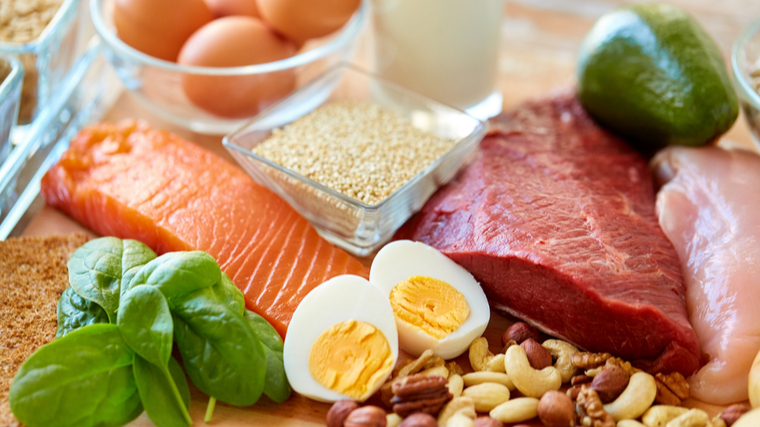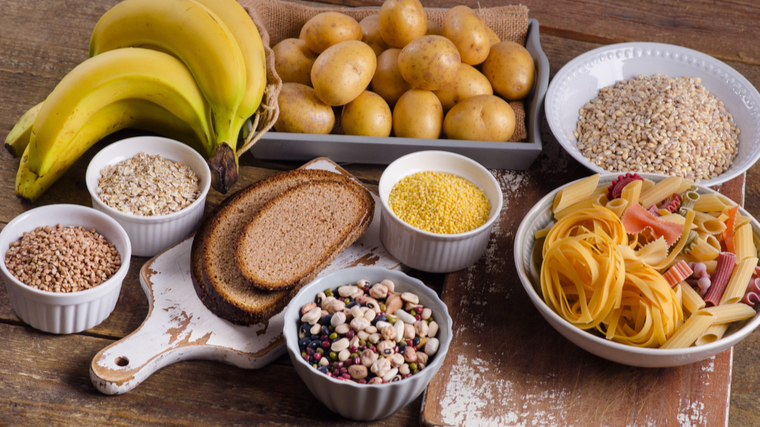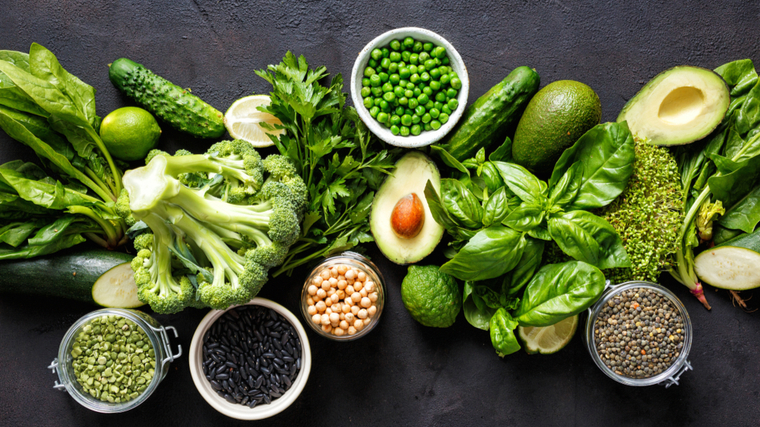If you’ve read any nutrition article, you’ve probably learned that getting the right amount of macronutrients and micronutrients is important. However, you might be left wondering — what are the differences between the two?
Macronutrients and micronutrients make up almost everything a human should ingest to ensure a healthy lifestyle. There are some exceptions, but we’ll get to that in a bit.
To break down the science and help you work out what matters most — and to make sure you know what you should be consuming outside of these two categories — we’ve collected some of the best literature as well as expert input from Natalie Rizzo, MS., RD., to help you understand the puzzle of nutrition.
Editor’s note: The content on BarBend is meant to be informative in nature, but it should not be taken as medical advice. The opinions and articles on this site are not intended for use as diagnosis, prevention, and/or treatment of health problems. It’s always a good idea to talk to your doctor before beginning a new fitness, nutritional, and/or supplement routine. None of these supplements are meant to treat or cure any disease. If you feel you may be deficient in a particular nutrient or nutrients, please seek out a medical professional.
Macronutrients Vs. Micronutrients — What’s the Difference?
Let’s start by defining the two. A macronutrient is usually measured in large units, specifically grams, while micronutrients are smaller nutritional components measured in milligrams or micrograms.
There are more differences than just that. Macronutrients are protein, carbohydrates, and fats — they’re what make up the caloric content of food. Micronutrients are vitamins and minerals, and each one helps facilitate a different bodily function, from your eyesight to regulating your internal temperature.
Macronutrients help with major needs like providing energy and maintaining muscle mass, while micronutrients assist bodily processes, regulation, and even brain function.
Macronutrients Explained
If you’ve ever taken a look at a diet calculator, you’ll see that you’ll be given a daily caloric goal to hit along with a macronutrient split, detailing the number of grams of protein, carbs, and fat you should eat every day. Calories from all three of the macronutrients have different effects on the body. For example, an average slice of cheese pizza has about 300 calories — about the same as 1 ½ cups of cottage cheese, depending on the brand.
The calories from the pizza are derived from refined grains, simple sugars, and lots of fats, whereas cottage cheese has plenty of protein-packed in. The pizza’s refined grains and simple sugars will raise blood sugar, meaning you might get hungrier quicker than if you chose cottage cheese. That’s because the extra protein in that cottage cheese helps keep you fuller for longer.

So while the main goal of either cutting weight or bulking up is to be in a caloric deficit (burning more calories than you consume) or surplus (eating more than you burn), getting the right type of calories is what matters most when it comes to building muscle or sustainably losing fat.
Additionally, you’ll want to make sure you’re focusing on quality as well as quantity. You could be hitting your carbohydrate mark day after day. Still, if you’re eating simple carbohydrates (white rice and pastries), you’ll find your energy stores won’t be as plentiful as if you were focusing on complex carbohydrates (such as whole wheat bread and pasta, or fruits and vegetables).
The same applies to protein and fat — literature suggests that high-quality, nutritious macronutrients can increase everything from gym performance to possibly long-term quality of life. (1)
Getting your macro balance right is crucial for getting your ideal physique. Here’s a quick 101 on each macronutrient. We’ll dive a little more in-depth afterward:
- Protein (4 calories per gram) you’ll find in large amounts in meat, eggs, dairy, and legumes, and it helps build and repair muscle. (2)
- Carbohydrates (4 calories per gram) you’ll get in grains, fruits, starches, and they help support energy levels and provide fiber, which improves digestive health and helps with nutrient absorption. (3)
- Fat (9 calories per gram) you’ll find in fatty meats, nuts, coconut, oils, seeds, and it’s important for hormonal health and to help you absorb nutrients. (4)
Protein
Protein is the macronutrient most gymgoers, and even those who don’t train, are familiar with. And while it’s often discussed when it comes to gaining muscle — it is the building block of muscles after all — it’s equally vital for those looking to lose weight.
Protein has been shown to increase satiety, or the feeling of being full, more than carbs or fats. Naturally, this leads to people eating less food and fewer calories, making a caloric deficit more achievable. Protein also helps increase thermogenesis in the body — meaning it takes more calories to digest protein than any other macronutrient. So you’re burning more calories without having to do anything actively. (5)
Best Protein Sources
Here are some protein sources recommended by the Cleveland Clinic:
- Edamame
- Lentils
- Chicken breast
- Greek Yogurt
- Low-fat cottage cheese
- Canned Tuna
- Egg Whites
Carbohydrates
Carbohydrates are essential for performance in and out of the gym, as they’re the body’s preferred source of energy. The carbs are converted into sugar and used for everything from lifting weights to walking down the stairs in the morning.
We touched on simple vs. complex carbohydrates already, but let’s discuss their consequences a little more. Simple carbs are digested by the body more quickly than complex carbohydrates. The more quickly you use that energy, the sooner you’ll need more energy. On the other hand, complex carbs provide more sustained energy — meaning you’ll be more energized for longer.

Complex carbs also help control blood sugar levels, preventing hunger pangs and preventing conditions such as type-2 diabetes. (6)
Best Carb Sources
Here are some of the best sources of carbohydrates, as suggested by the Mayo Clinic:
- Barley
- Brown rice
- Oatmeal
- Whole-wheat bread or pasta
Fat
You’ve probably heard that fat is bad for you, and that’s not entirely true. Yes, fat does have more calories per gram than carbs or protein, so it’s a little more…well, fattening. That doesn’t mean you need to cut it out of your life altogether. Vitamins A, D, E, and K are fat-soluble, meaning for them to be absorbed in the body, there needs to be some fat present in your diet.
Fat is also necessary for some hormonal functions. Low-fat diets have been linked to lower testosterone counts in men — and testosterone is vital to muscle growth and other activities conducted outside of the gym. (7)
Best Fat Sources
Here are some examples of “good” fats, provided by the American Heart Association:
- Avocado
- Albacore tuna
- Salmon
- Almonds
- Hazelnuts
- Peanuts
- Walnuts
Micronutrients Explained
Micronutrients are vitamins, minerals, and other chemicals. Unlike macros, they don’t have calories. They often accompany calories — if you eat yogurt, you’ll get calcium along with the protein and fat and carbs, but the calcium itself doesn’t have calories.
Some micros are easier to get than others. Vitamin C is so common that you can get more than a day’s worth from one orange or one cup of broccoli. Most people are deficient in vitamin D, which is very hard to find in foods.
“It’s one of those micros where most people should take a supplement,” says Rizzo. “Because Vitamin D is actually crucial for bone health. We tend to think of calcium (as the bone health nutrient), but Vitamin D is important for that as well.”

Other micronutrients that are tricky to get in your diet include magnesium (found in leafy greens), which helps with sleep quality and stress reduction, and selenium (found in nuts and seafood), an antioxidant that reduces inflammation. (8)(9)(10)(11)
There are far too many micronutrients for us to break them all down individually. A physician or dietitian will be able to tell you if you’re deficient in any of them, and will be able to prescribe a treatment plan to get your levels up. If you’re concerned you might have a deficiency, you could take a multivitamin or green powders to ensure you’re getting all of your essential nutrients.
Not Everything Is a Macronutrient or Micronutrient
That’s the long and short of macros vs. micros, but some things we ingest don’t fall neatly into those categories.
Water
“Sometimes people say water is a macronutrient because we measure it in grams,” says Rizzo. “But it’s tricky because there are no set requirements for how much water you should have. Some people call it a macronutrient. I don’t know if it is one, but you could consider it one.”
Fiber
Fiber is a type of carbohydrate, but concerning insoluble fiber (found in grains and legumes and many fruits), it passes through the body and isn’t really absorbed. It helps give bulk to your stool, slow digestion, minimize blood sugar spikes, and decrease cholesterol absorption. The list goes on. (12)(13).
But because so much of it goes unabsorbed, it’s controversial whether the calories “count” from fiber.
“I’ve never really seen research on how many calories are absorbed in terms of fiber, and I feel like that’d be really difficult to figure out,” says Rizzo. “I don’t know if people subtract the calories in fiber, though they often subtract the carbs in fiber from their macros. But the bottom line is those calories still count.”
Alcohol
Alcohol contains 7 calories per gram — but those calories aren’t protein or fat, and it’s not really a carb, strictly speaking. Although some macro trackers will call it a macro, it doesn’t give us energy the same way that protein or fats do, and is not comfortably processed by the body.
“I haven’t heard alcohol called a macro in school, but we tend to think of macronutrients in terms of the calories you’ll get for a gram,” says Rizzo.
Calories from alcohol are thought to be so-called “empty” calories or calories that provide no nutritional value. That is, they contain no micronutrients at all. But alcoholic drinks could provide some nutritional value — wine, for example, has antioxidants and flavonoids from the grapes it’s made from.
Whether or not you consider it a macro, it is not an essential nutrient.
Omega-3 Fatty Acids
These are indeed types of fat, so they are under the “fat” umbrella, but we include it here because Omega-3 content isn’t something you see on a standard nutrition label. Nutrition labels only say “fat,” and maybe how much of it is unsaturated or saturated. On rare occasions, a nutrition label will mention how much is polyunsaturated fat, but Omega-3 is just one kind of polyunsaturated fat.
Omega-3s have close links to various benefits, from fighting depression and anxiety to protecting your joints. Its main benefit, though, is improving various markers related to heart health. (14)

“Technically, Omega-3s are fat, but that’s another one we do not see on labels,” says Rizzo. “And there’s a ton of research that Omega-3s are beneficial for heart health and cognitive function. So there are things that are definitely left out in terms of macronutrients and micronutrients.”
Phytonutrients
Phytonutrients are found in plants, and they include antioxidants, flavonoids, polyphenols, and various other chemicals that contribute to our overall health.
“There are a million kinds of them,” says Rizzo. “There’s anthocyanin, flavonoids, all these different ones that are in all these fruits and vegetables, and they’re very hard to measure.”
Take broccoli, for example. It includes phytonutrients like:
- Indole-3-Carbinol, linked to hormonal health
- Isothiocyanates, linked to lower inflammation
- Glucosinolates, linked to antifungal and antimicrobial effects
But none of these are technically vitamins or minerals, and they’re not considered essential for proper human functioning. They’re very good for human functioning.
“Even if we did know how much of it you need in a day, there are no set standards there like with macronutrients and micronutrients,” says Rizzo.
Probiotic Bacteria
Probiotics don’t provide calories, but they do provide benefits. Our digestive tract contains trillions of bacteria that help us break down and digest food, and consuming more of them — found in supplements or fermented foods like yogurt, sauerkraut, and kimchi — may help improve digestive health and decrease inflammation. (15)
The Takeaway
Macros and micros aren’t one hundred percent of your nutrition, but they’re hugely important and broadly considered the foundation of a healthy diet when it comes to maintaining your health.
Macros are pretty much everything when it comes to weight loss and weight gain, and hitting the recommended intake of your micronutrients is linked to everything from better sleep to a stronger immune system or higher testosterone levels — they are the “meat and potatoes,” if you will, of your nutrition.
Micronutrients don’t help the scale budge or directly affect how many plates you can throw on a barbell at the gym. Still, they are equally critical for internal processes, maintaining homeostasis, and keeping your systems functioning optimally around the clock.
The bottom line is this: don’t just eat sugar, protein powder, butter, and multivitamins. Eat a lot of whole foods and a broader spectrum of macros, micros, fiber, phytonutrients, and your body will thank you for it.
References
- Shan Z, Guo Y, Hu FB, Liu L, Qi Q. Association of Low-Carbohydrate and Low-Fat Diets With Mortality Among US Adults. JAMA Intern Med. 2020;180(4):513–523. doi:10.1001/jamainternmed.2019.6980
- Santarpia L, Contaldo F, Pasanisi F. Dietary protein content for an optimal diet: a clinical view. J Cachexia Sarcopenia Muscle. 2017 Jun;8(3):345-348. doi: 10.1002/jcsm.12176. Epub 2017 Apr 25. PMID: 28444858; PMCID: PMC5476844.
- Slavin J, Carlson J. Carbohydrates. Adv Nutr. 2014 Nov 14;5(6):760-1. doi: 10.3945/an.114.006163. PMID: 25398736; PMCID: PMC4224210.
- Liu AG, Ford NA, Hu FB, Zelman KM, Mozaffarian D, Kris-Etherton PM. A healthy approach to dietary fats: understanding the science and taking action to reduce consumer confusion. Nutr J. 2017 Aug 30;16(1):53. doi: 10.1186/s12937-017-0271-4. PMID: 28854932; PMCID: PMC5577766.
- Douglas Paddon-Jones, Eric Westman, Richard D Mattes, Robert R Wolfe, Arne Astrup, Margriet Westerterp-Plantenga, Protein, weight management, and satiety, The American Journal of Clinical Nutrition, Volume 87, Issue 5, May 2008, Pages 1558S–1561S,
- Crapo PA. Simple versus complex carbohydrate use in the diabetic diet. Annu Rev Nutr. 1985;5:95-114. doi: 10.1146/annurev.nu.05.070185.000523. PMID: 2992551.
- Fantus, R. J., Halpern, J. A., Chang, C., Keeter, M. K., Bennett, N. E., Helfand, B., & Brannigan, R. E. (2020). The Association between Popular Diets and Serum Testosterone among Men in the United States. The Journal of urology, 203(2), 398-404.
- Cao Y, Zhen S, Taylor AW, Appleton S, Atlantis E, Shi Z. Magnesium Intake and Sleep Disorder Symptoms: Findings from the Jiangsu Nutrition Study of Chinese Adults at Five-Year Follow-Up. Nutrients. 2018 Sep 21;10(10):1354. doi: 10.3390/nu10101354. PMID: 30248967; PMCID: PMC6212970.
- Schnabel R, Lubos E, Messow CM, Sinning CR, Zeller T, Wild PS, Peetz D, Handy DE, Munzel T, Loscalzo J, Lackner KJ, Blankenberg S. Selenium supplementation improves antioxidant capacity in vitro and in vivo in patients with coronary artery disease The SElenium Therapy in Coronary Artery disease Patients (SETCAP) Study. Am Heart J. 2008 Dec;156(6):1201.e1-11. doi: 10.1016/j.ahj.2008.09.004. PMID: 19033020; PMCID: PMC3624729.
- Puspitasari IM, Abdulah R, Yamazaki C, Kameo S, Nakano T, Koyama H. Updates on clinical studies of selenium supplementation in radiotherapy. Radiat Oncol. 2014 May 29;9:125. doi: 10.1186/1748-717X-9-125. PMID: 24885670; PMCID: PMC4073179.
- Cai X, Wang C, Yu W, Fan W, Wang S, Shen N, Wu P, Li X, Wang F. Selenium Exposure and Cancer Risk: an Updated Meta-analysis and Meta-regression. Sci Rep. 2016 Jan 20;6:19213. doi: 10.1038/srep19213. PMID: 26786590; PMCID: PMC4726178.
- Lambeau KV, McRorie JW Jr. Fiber supplements and clinically proven health benefits: How to recognize and recommend an effective fiber therapy. J Am Assoc Nurse Pract. 2017 Apr;29(4):216-223. doi: 10.1002/2327-6924.12447. Epub 2017 Mar 2. PMID: 28252255; PMCID: PMC5413815.
- Fuller S, Beck E, Salman H, Tapsell L. New Horizons for the Study of Dietary Fiber and Health: A Review. Plant Foods Hum Nutr. 2016 Mar;71(1):1-12. doi: 10.1007/s11130-016-0529-6. PMID: 26847187.
- Ruxton C. Health benefits of omega-3 fatty acids. Nurs Stand. 2004 Aug 11-17;18(48):38-42. doi: 10.7748/ns2004.08.18.48.38.c3668. PMID: 15366399.
- Gupta V, Garg R. Probiotics. Indian J Med Microbiol. 2009 Jul-Sep;27(3):202-9. doi: 10.4103/0255-0857.53201. PMID: 19584499.
Featured Image: George Rudy/Shutterstock